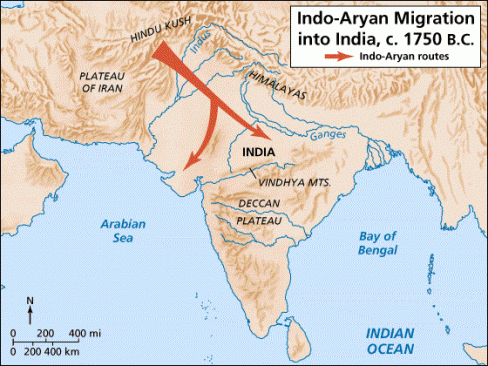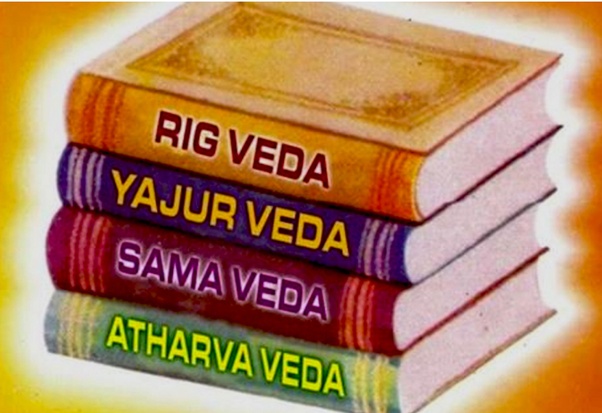The Vedic period or Vedic age (c. 1500 – c. 500 BCE), is the period in the history of the northern Indian subcontinent between the end of the urban Indus Valley Civilisation and second urbanization which began in the central Indo-Gangetic Plain c. 600 BCE. It gets its name from the Vedas, which are liturgical texts containing details of life during this period that have been interpreted to be historical and constitute, the primary sources for understanding the period.

After the decline of the Indus Valley Civilization, another glorious civilization flourished in India. The people who were responsible for the evolution of this civilization called themselves Aryas or Aryans. Arya literally means the man of ‘noble character’, and the “free-born”. They belonged to the group of people known as Indo-Europeans. They entered India from the north-west.
Although the Rig Veda deals with devotional work of religious nature, yet it gives a vivid picture of the early Vedic civilization. Vedic Civilization is best understood from social life, political organization, economic life, and religious beliefs.
They spoke the Indo-European languages from which modern languages like Sanskrit, Persian, Latin, Greek, Celtic, and Gothic have developed. Originally, the Aryans seem to have lived somewhere in the area east of the Alps, known as Eurasia.
European Origin
The early Aryans were familiar with certain animals such as goats, dogs, pigs, cows, horses, etc. and also with the trees like pine, maple, oak, willow, birch, etc. which are found in Europe. It is generally believed that they migrated to India and other parts of Asia from Europe.
It is difficult to locate the exact part of Europe where the Aryans originally lived before they migrated elsewhere. According to Giles, Balkan countries were the original home of the Aryans. The flora and fauna and the animals with which the early Aryans were familiar could be found in the Balkan countries at that time.
Some historians believe that the Aryans migrated from Lithuania Europe into the Caucasus and from there they entered into Iran. Again from Iran, they entered Punjab. This view is proved by the discovery of the Boghaz Koi inscription and the Tel-El- Amarna Letters in Western Asia.
Migration from Southern Russia
Some historians held the view that the Aryans entered India from the region of South Russia. Brandenstain has suggested that the Aryans migrated to India from the Kirghiz steppe in Russia. The great Philologist, Schrader accepts South Russia as the original home of Russians from where they migrated to different areas.
Indian Origin
Few historians believed the view that Aryans belonged to India. The Rig Veda refers to ‘Sapta Sindhu’ land (of seven rivers) which was the name of Punjab. Subsequently, it was called “Panchanada” (land of five rivers). The flora and fauna with which the Aryans were familiar are not found in Punjab. Again the fertility of Punjab must have attracted immigration. From the linguistic viewpoint, Greek and Latin belong to the Aryan group of Languages. These considerations led historians to believe that Aryans do not originally belong to India.
From the linguistic study, it is proved that the Aryans migrated from Europe or Asia to India. For example, ‘Pater’ and ‘Mater’ of Latin, “Father’, and ‘Mother’ of English resemble ‘Pitru’ and ‘Matru’ of Sanskrit. So the historians generally accepted the view that Aryans migrated from Europe or Asia to India.
The Aryans first appeared in Iran on their way to India, where the Indo-Iranians lived for a long time. From Rig Veda, which is the earliest specimen of Indo-European language we know about the Aryans. The Rig Veda consists of ten mandalas or books. It is a collection of prayers offered to Agni, Indra, Mitra, Varuna, and other gods by various families of poets or sages.
Rig Veda has many things in common with the ‘Avesta’ of Iran. The ‘Rig Veda’ and ‘Avesta’ use the same names for several gods and even for several classes. Some Aryan names engraved in the Kassite inscriptions of 1600 B.C. and the Mittani inscriptions of the fourteenth century B.C. found in Iraq prove that from Iran a branch of the Aryans moved towards the west.
Home of the Aryans in India
The Aryans appeared in India a little earlier than 1500 B.C. The earliest Aryans settled down in eastern Afghanistan, Punjab, and fringes of Uttar Pradesh. The Rig-Veda mentioned the names of some rivers of Afghanistan such as the river Kubha, and the river Indus and its five branches. The earliest settlements of Aryans were confined to the valleys of the river Sindh and its tributaries and the Saraswati and the Drishadvati.
Though they were confined mainly in Punjab, yet their outer settlements reached to the banks of the Ganga and the Yamuna. They named that region Madhya Desa. Gradually they occupied the whole of Uttarapatha, the loan between the Himalayas and the Vindhyas and from the western seas to the east was called as Aryavarta.
The Vedas

The Vedas form the oldest literary works of the Aryans and occupy a very distinguished place in the history of the world literature. Vedas have been looked upon as the revealed words of God by millions of Hindus. In course of many centuries, Vedas had grown up and was orally handed down from generation to generation. The Vedas were probably authored during 1800 BC and 600 BC. It consists of three successive classes of literary production.
These three classes are:
- The Samhitas or Mantras—these are collections of hymns, prayers, charms, litanies, sacrificial formulas.
- The Brahmanas—a kind of Primitive theology and philosophy of Brahmanas.
- The Aranyakas and Upanishads—they are partly included in the Brahmanas or attached thereto and partly exist as separate work. They contain philosophical meditations of the hermits and ascetics on the soul, God, world & man.
There are four Samhitas which are different from one another.
- The Rigveda Samhita: A collection of hymns. It has ten mandalas with a total of 1028 ‘Suktas’ or ‘stutis” for the worship of gods like Indra, Surya, Agni, Yama, Varuna Ashwini, Usha, etc.
- Samaveda Samhita: A collection of songs mostly taken from Rig Veda. It contained 1549 stutis. A special class of priests known as “Udgator” was to recite its hymns.
- Yajur Veda Samhita: A collection of sacrificial formula. It has 40 mandals. There are two distinct forms of Yajur Veda namely. “Sukla Yajur Veda” and “Krishna Yajur Veda”. The “Sukla Yajur Veda” contains the genesis while the “Krishna Yajur Veda” describes the “Vasya” or the philosophy.
- Atharva Veda Samhita: A collection of songs and spells. It has twenty mandalas with 731 ‘stutis’. It deals with magic, hypnotism, enslavement through mantra. It is regarded on a lower level than the other three Vedas. These four Samhitas formed the basis of four Vedas. Every work belonging to the second and third classes of Vedic literature viz, the Brahmanas, the Aranyakas, and the Upanishads, is attached to one or another of these Samhitas and is said to belong to that particular Veda.
The Authorship of the Vedic Literature
The Hindus have a belief that the hymns were merely revealed to the sages and not composed by them. .For this Vedas are called “apaurusheya’ (not made by man) and ‘ritya” (existing in all eternity). The ‘Rishis’ to whom they are ascribed are known as Mantradrasta’. (Who received the mantra by sight directly from the Supreme Creator).
Vedangas
Besides the Vedas, there is another class of works whose authorship is ascribed to human beings. They are known as Sutras or Vedas. There are six Vedangas. They are six subjects. These are siksha (pronunciation), changes (meter) Jyotisha (astronomy), Kalpa (ritual), Vyakarana (grammar), Ninukta (explanation of words).
Religious Life of Early Vedic Age
Nature worship was predominant in religious life during the Vedic Age. It will believe that when Vedic Aryan failed to understand the causes behind different natural activities such as the rise of the sun, blowing of the wind, five & rainfall, etc. these natural forces were giving the name of Gods & Goddess.
Human attributes were attached to deities. The personification of forces of nature was an important feature of the religious life of the Vedic Age. The Vedic religion was polytheistic in nature because Vedic Aryans believed in multiple Gods & Goddess.
Male Gods enjoyed a higher status in Vedic religion. The status of female deities was inferior. Vedic religion was similar to Henotheism / Kathenotheism. It is a system of religion in which one particular God is held supreme on a particular occasion. Some highest status was scribed/given to another deity on other occasions. The cult of domestic health enjoyed a place of great significance in Vedic religion because most of the offerings were made in kitchen fire for deities. Rituals & sacrifices formed the crucks of the Vedic religion.
During the Early Vedic Age, the rituals & ceremonies were simple in nature. The role of the priestly class was not important in religious life during the Early Vedic Age. There were 16 categories of priestly class during the Early Vedic Age. Brahman priest was one of them. The householder was considered as a priest of the 17th Most of the rituals & sacrifices were performed by the householder himself. Philosophical elements were in the nascent stage of development during the Early Vedic Age. Only a faint reference of heaven & hell is found in Rig-Veda. Philosophical elements such as soul & salvation were yet to emerge.
The materialistic outlook was dominant in the Early Vedic religion because ritual & ceremonies were performed for sons, victory on the battlefield & for cattle wealth (cows). Early Vedic religion was liberal & progressive Rigidities & complexities were absent. The ultimate object of the religious act appears to be the battement of life.
Religious Life of Later Vedic Age
The status of some deities changed to the Later Vedic Age. During Early Vedic Age Varuna, Indra & Agriculture were the three most prominent deities. But during the Later Vedic Age, Prajapita Brahma, Vishnu, Rudra were the most important deities. Rituals & scarifies become elaborate costly & complex.
Some of the sacrifices such as Rajsuya, Vajpaya & Ashwamedha used to continue for days & months together. The role of the priestly class increased in religious activities. Brahmana emerged as the most important priestly class. Pessimist ideas like Asceticism & renunciation of life become a part of religion during the Later Vedic Age.
The philosophical dimension of religion emerged during this age concept like Heaven, Soul, Rebirth, Transmigration & salvation emerged during this period. Spiritual & philosophical outlook became dominant in the Later Vedic Age because rituals & ceremonies were no longer performed for material benefits. Attainment of salvation & heaven was the main object of religious activities during the Later Vedic Age.

